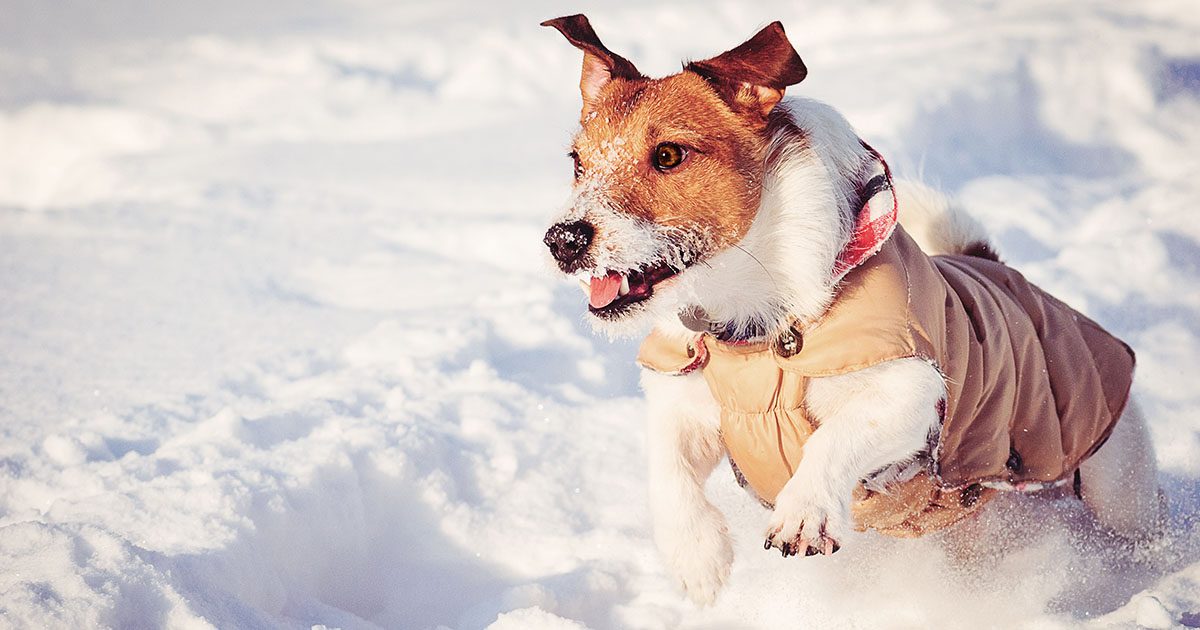Every year when the cold temperatures arrive, you pull out your heavy sweaters, winter coats, boots, gloves, hot water bottles and flannel sheets. But what about your dog when the temperature drops? Can they tolerate cold temperatures? And what are some ways you can help them stay warm? We’ve compiled some winter pet care tips to help keep your furry friends comfortable and safe.
Do Dogs Get Cold in the Winter?
Many dogs can tolerate most cold-weather conditions — as long as they have time to acclimate to the chillier air temperatures. If you consistently walk your dog outside as summer gives way to fall and then winter, they will naturally adjust to colder weather. But if your dog spends most of their time indoors (or in warmer climates and you plan on taking them someplace cold for the holidays), you’ll need to gradually introduce them to and shelter them from the colder air temperature.
Do Dogs Get Cold Like Humans?
Just like people, a dog’s ability to tolerate the cold can vary with their breed, the type and density of their coat, their age, the amount of body fat they have, their activity level and their health. It may seem obvious that dog breeds with thin coats will have trouble maintaining their body temperature on chilly days. But even breeds with long fur or those with thick coats will start having trouble tolerating the cold once they’ve become senior dogs. All dogs show signs when they feel the cold, so watch out for these symptoms and behavioral clues:
- Shivering
- Whining or whimpering
- Standing at the door of your home
- Seeking another type of shelter
How to Keep Dogs Warm While Outside in Winter
It may be tempting to limit your dog’s time outdoors during the winter months. But even if your dog is one of the short-haired breeds, you can help them tolerate cold weather and get some great outdoors time all year round.
Just as you invest in sweaters and down coats to keep warm, you may need to buy cold weather apparel for your pup to stop them feeling the chill in the air. Sweaters or coats with insulation can be especially helpful for short-coated dogs whether they’re being walked or being allowed outside to relieve themselves. If possible, you’ll want to get your pet accustomed to wearing a jacket or sweater before cold temperatures arrive so that they’re comfortable being dressed.
Again, be aware of the signs that your dog needs some extra warmth. No matter how cold-tolerant they are, on particularly chilly days you may not be able to let your dog stay outside for extended periods. Those days are your chance to try a food puzzle or other toys suitable for playtime in the comfort of your house!
Don’t Forget Your Dog’s Feet in Cold Weather
Winter cold and snow can be tough on paw pads, so protecting your dog’s paws becomes even more important during cold months. Be sure to rinse (or at least wipe) and dry your dog’s feet after each trip outside, especially if they’ve been walking in areas where deicers have been used. You’ll also want to monitor your dog’s paws for ice or snow that collected between the toes and for cracks in the paw pads. A pet-safe balm applied to pads can help prevent dryness and cracking. Waterproof booties, if your dog will wear them, offer the best protection for paw pads and provide traction on icy surfaces. Protective paw wax is also available and can provide a semipermeable barrier between paws and salty sidewalks.
How to Keep Outside Dogs Warm in Winter
Any dog that spends substantial time outdoors should have access to an insulated shelter that keeps them dry and out of the wind. Their house should be just large enough for them to stand up, turn around and lie down comfortably. The shelter’s floor should be off of the ground to minimize heat loss, and bedding (e.g., straw) should be thick, dry and changed often. Don’t use towels, blankets or rugs because the fabric can absorb moisture and freeze.
Most dogs who spend time outdoors in winter will need more food (calories) so they can maintain their body temperature. How much to feed them will depend on their activity level, housing and the outdoor temperature. Remember, dogs should always have access to fresh, unfrozen water.
How Cold Is Too Cold for Dogs?
Extreme cold and subzero wind chills are always exceptions, even with conditioning in the winter environment. It can simply get too cold for even the hardiest snow-loving dogs to spend long periods of time outside without proper shelter and nutrition. All owners should be aware that their dogs can develop cold-weather-related health problems, including hypothermia and frostbite on their skin, after exposure to temperatures below 20 degrees Fahrenheit.
When it comes to winter dog care, be sure to plan ahead. In general, dogs aren’t any more immune to cold weather than we are. If it’s cold for people, it’s probably cold for dogs!







